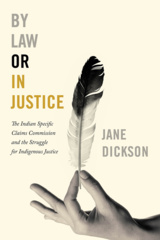The Honour and Dishonour of the Crown
Making Sense of Aboriginal Law in Canada
The fundamentals of Aboriginal law in Canada are unclear and Indigenous communities lack appropriate guidance in terms of efficiently accessing the legal system to address breaches of their rights. Jamie Dickson states this is yet another grievance endured by Aboriginal peoples in Canada. He contends it is a positive development that the Supreme Court of Canada has begun to place greater emphasis on the honour of the Crown principle and less on the paternalistic, complex notion that governments owe a fiduciary duty to Aboriginal peoples. Dickson explores both theoretical and practical implications of this fundamental shift in Aboriginal law. This book will be of particular interest to legal professionals, Indigenous studies scholars, and policy advisors.
“Unique within Canadian legal writing, this book unpacks the complex conceptual differences between the fiduciary duty of the Crown and the honour of the Crown. Unnoticed by many working in Aboriginal law, the Supreme Court has shifted between these concepts, and Dickson shows why it matters.”
—Dwight Newman, Canada Research Chair in Indigenous Rights in Constitutional and International Law, University of Saskatchewan, author of Revisiting the Duty to Consult Aboriginal Peoples.
“Jamie Dickson makes a compelling case for the need to develop a principled legal framework regarding section 35 and the principle of honour of the Crown. This book makes a substantive contribution to our understanding of where section 35 is at in its development and where it needs to go to achieve its fundamental objective of reconciliation.”
—Thomas Isaac, Partner at Osler, Hoskin and Harcourt LLP, author of Aboriginal Law: Commentary and Analysis (4th ed.).
Unique within Canadian legal writing, this book unpacks the complex conceptual differences between the fiduciary duty of the Crown and the honour of the Crown. Unnoticed by many working in Aboriginal law, the Supreme Court has shifted between these concepts, and Dickson shows why it matters.
Jamie Dickson makes a compelling case for the need to develop a principled legal framework regarding section 35 and the principle of honour of the Crown. This book makes a substantive contribution to our understanding of where section 35 is at in its development and where it needs to go to achieve its fundamental objective of reconciliation.
Jamie Dickson is vice-president in charge of legal affairs at Des Nedhe Development, which is the economic development organization of English River First Nation in Saskatchewan. Prior to that role, he worked in private practice with a national business law firm, as corporate counsel for a major resource development company, and as a consultant for First Nations in various contexts.
Dickson has represented both First Nations and industry in negotiating major collaboration agreements in the resources sector. Notably, Dickson has successfully negotiated multi-million-dollar agreements in both Saskatchewan and Western Australia. Having acted extensively for both First Nations and industry, Dickson brings a unique perspective to the issues examined in this book.
In 2014, Dickson completed his Master of Laws program at the University of Saskatchewan. As part of that program, he wrote a master’s thesis entitled “The Honour of the Crown: Making Sense of Crown Liability Doctrine in Crown/Aboriginal Law in Canada.” That thesis formed the basis for this book.
Dickson lives in Saskatoon with his wife Anna and son Calvin.
Acknowledgements
I: Introduction
II: The Honour of the Crown Principle
a. The “honour of the Crown” prior to Haida Nation
b. The “honour of the Crown” as reimagined in Haida Nation
c. The “honour of the Crown” as applied after Haida Nation
III: Conventional Fiduciary Law
a. Function of fiduciary accountability
b. Content of fiduciary duties
c. Contexts in which fiduciary duties arise
IV: Fiduciary Law as Applied, Nonconventionally, in Crown/Aboriginal Contexts
a. Function of Crown/Aboriginal fiduciary accountability
b. Content of Crown/Aboriginal fiduciary duties
c. Contexts in which Crown/Aboriginal fiduciary duties arise
V: Crown/Aboriginal Fiduciary Doctrine as a “Mistake”
VI: The New Face of Aboriginal Law in Canada
a. Central role of the honour of the Crown principle
b. Limited role for Crown/Aboriginal fiduciary duties
i. Conventional Crown/Aboriginal fiduciary accountability
ii. Nonconventional Crown/Aboriginal fiduciary accountability
c. Practical implications of replacing the “Crown as fiduciary” concept with the “honour of the Crown” principle
d. The significance of the mandate to “reconcile” Crown and Aboriginal interests
VII: Conclusion










